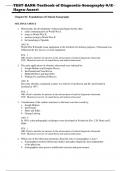Examen
TEST BANK FOR Textbook of Diagnostic Sonography 9th Edition by Sandra L. Hagen-Ansert , ISBN: 9780323826464 All Chapters 1-29| Complete Guide A+
- Cours
- Établissement
- Book
Test Bank for Textbook of Diagnostic Sonography, 9th Edition Volume 1 by Sandra L. Hagen-Ansert. Volume one all chapters test bank included Chap 1 -30 VOLUME ONE Part I: Foundations of Sonography 1. Foundations of Clinical Sonography 2. Essentials of Patient Care for the Sonographer 3. Ergonomics a...
[Montrer plus]




